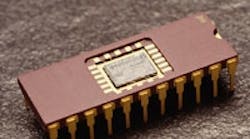Consumers' seemingly unfailing appetite for ever lighter, faster and technically enhanced electronic consumer goods has been fuelling a steadily-rising demand for gold from manufacturers. An essential material in many electronic devices like laptops, iPods and cell phones, gold's immunity to environmental effects means that the technical performance of the metal remains essentially unchanged by time. Where the voltages are small, the operating conditions arduous, the circuitry complex, or reliability must be high; gold is usually the preferred material choice. According to precious metals consultancy firm GFMS, during 2007 311 tons of gold found its way into electronics devices, more gold than that used in all U.S. jewelry purchases in the same year. This article takes a current look at this important application of gold.
The Applications
Gold-plated contacts and connectors are probably the most obvious and visual use of gold by the electronics industry. As an example, a quick examination of a cell phone will almost certainly reveal gold-plated components around the battery and charging points. The choice of the best material for a contact or a connector is complex, and compromises are usually needed, but gold is generally considered the best material for low-voltage, low-current and low-contact-force applications. When two gold surfaces are brought together into intimate contact, the resulting electrical connection offers unrivalled low resistance and stability. To minimize cost, the thickness of gold used is always the minimum compatible with the performance required and this will depend on the operating conditions. Connectors for use in clean, ambient environments may require as little as 0.1 micron of gold.
What is the Cost of a Rising Gold Price?
With the gold price recently marking a record high and breaking through the $1,000/oz barrier (although currently hovering under $900), the electronics industry would like to reduce its consumption of gold, which exceeded $7 billion in 2007. For contacts and connectors the rising price has led manufacturers to consider how best they can reduce costs in gold plating. One obvious way is to seek the same performance at an even further reduced gold coating thickness. Such a strategy can have risks, however, because as the coating thickness is reduced so porosity in the coating increases, which can lead the connector to fail through corrosion of the underlying layers. Manufacturers have also been prompted to reconsider the use of a number of alternative coatings such as palladium-nickel. However, in some situations palladium coatings can catalyze the formation of insulating polymeric materials on their surfaces and can potentially lead to reliability issues.
A Recyclable Metal
Looking Ahead
It is not yet clear if future generations of electronic products will rely on the use of gold in key components, but World Gold Council, funded by the world's leading gold mining companies is seeking to ensure it remains both the material of choice in existing applications and a critical part of radical new technologies. Potential new areas of application for gold include the use of gold compounds in organic light emitting diodes and optoelectronic devices.
So despite the ever present need for reduced material costs, future electronics manufacturing technologies will almost certainly demand material properties that can only be found in gold and its alloys. Without doubt gold will remain of the utmost importance to the electronics industry for many years to come.
Richard Holliday is head of Industrial Applications for the World Gold Council. More information on the uses of gold in electronics can be found at www.gold.org



